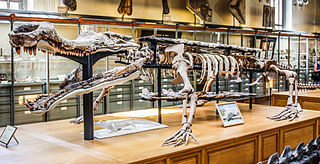
Sarcosuchus is an extinct genus of crocodyliform and distant relative of living crocodylians that lived during the Early Cretaceous, from the late Hauterivian to the early Albian, 133 to 112 million years ago of what is now Africa and South America. It was one of the largest crocodile-line reptiles, reaching an average estimate of 9 m (30 ft) and 3.5 metric tons, but estimated to grow up to 9.5 m (31 ft) in body length and weigh up to 4.3 metric tons. It is known from two species, S. imperator from the early Albian Elrhaz Formation of Niger and S. hartti from the Late Hauterivian of northeastern Brazil, other material is known from Morocco and Tunisia and possibly Libya and Mali.
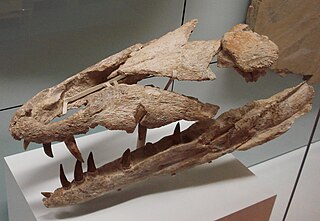
Dakosaurus is an extinct genus of crocodylomorph within the family Metriorhynchidae that lived during the Late Jurassic and Early Cretaceous. It was large, with teeth that were serrated and compressed lateromedially. The genus was established by Friedrich August von Quenstedt in 1856 for an isolated tooth named Geosaurus maximus by Plieninger. Dakosaurus was a carnivore that spent much, if not all, its life out at sea. The extent of its adaptation to a marine lifestyle means that it is most likely that it mated at sea, but since no eggs or nests have been discovered that have been referred to Dakosaurus, whether it gave birth to live young at sea like dolphins and ichthyosaurs or came ashore like turtles is not known. The name Dakosaurus means "biter lizard", and is derived from the Greek dakos ("biter") and σαῦρος -sauros ("lizard").

Allodaposuchus is an extinct genus of crocodyliforms that includes four species that lived in what is now southern Europe during the Campanian and Maastrichtian stages of the Late Cretaceous. Although generally classified as a non-crocodylian crocodylomorph, it is sometimes placed as one of the earliest true crocodylians. Allodaposuchus is one of the most common Late Cretaceous crocodylomorphs from Europe, with fossils known from Spain, Romania, and France.

Geosaurus is an extinct genus of marine crocodyliform within the family Metriorhynchidae, that lived during the Late Jurassic and the Early Cretaceous. Geosaurus was a carnivore that spent much, if not all, its life out at sea. No Geosaurus eggs or nests have been discovered, so little is known of the reptile's lifecycle, unlike other large marine reptiles of the Mesozoic, such as plesiosaurs or ichthyosaurs which are known to give birth to live young out at sea. Where Geosaurus mated, whether on land or at sea, is currently unknown. The name Geosaurus means "Mother of Giants lizard", and is derived from the Greek Ge- and σαῦρος -sauros ("lizard"). The name Geosaurus was established by the French naturalist Georges Cuvier in 1824.
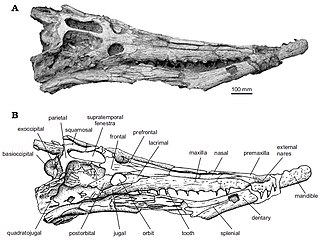
Dyrosauridae is a family of extinct neosuchian crocodyliforms that lived from the Late Cretaceous (Maastrichtian) to the Eocene. Dyrosaurid fossils are globally distributed, having been found in Africa, Asia, Europe, North America and South America. Over a dozen species are currently known, varying greatly in overall size and cranial shape. All were presumably aquatic, with species inhabiting both freshwater and marine environments. Ocean-dwelling dyrosaurids were among the few marine reptiles to survive the Cretaceous–Paleogene extinction event.
Rugosuchus is an extinct genus of neosuchian crocodyliform from the late Early Cretaceous of China. It is known from most of a skull, a partial postcranial skeleton, and a second partial skeleton including part of the hips. It was described by Xiao-Chun Wu and colleagues in 2001, with R. nonganensis as the type species. At the time of its description, it was the most complete crocodyliform from northeastern China, and only the second known.

Araripesuchus is a genus of extinct crocodyliform that existed during the Cretaceous period of the late Mesozoic era some 125 to 66 million years ago. Six species of Araripesuchus are currently known. They are generally considered to be notosuchians, characterized by their varied teeth types and distinct skull elements. This genus consists of other five related species: A. wegeneri and A. rattoides, discovered in Niger, A. tsangatsangana, discovered in Madagascar, A. gomesii, discovered in Brazil and another species discovered in Argentina, A. patagonicus.
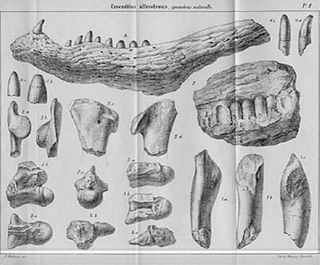
Massaliasuchus is an extinct genus of allodaposuchid crocodylian that is known from fossils found in Santonian–Campanian-age Upper Cretaceous rocks of southeastern France.

Iharkutosuchus is an extinct genus of basal eusuchian crocodyliform. Its fossils have been found in the Santonian-age Upper Cretaceous Csehbánya Formation in the Bakony Mountains of western Hungary. It is based on MTM 2006.52.1, a nearly complete skull, and several other partial skulls, isolated skull bones, and numerous teeth are also known. Iharkutosuchus was a small crocodyliform. Its skull was low, and the snout was short. Iharkutosuchus is unusual in its heterodonty: some of its teeth were complex and multicusped, like mammal teeth. The structure of the skull indicates that it could grind food with a mobile lower jaw, and together with the teeth suggest a diet of fibrous plant material. The genus was described in 2007 by Attila Ősi and colleagues. The type species is I. makadii, for László Makádi.
Cynodontosuchus is an extinct genus of baurusuchid mesoeucrocodylian. Fossils have been found from Argentina of Late Cretaceous age from the Bajo de la Carpa Formation as well as the Pichi Picun Leufu Formation. Fossils also have been found in the Tiupampan Santa Lucía Formation of Bolivia.
Hylaeochampsidae is an extinct family of basal eusuchian crocodylomorphs thought to be closely related to the order Crocodylia. It was first constructed by Charles William Andrews in 1913 to include just one member: Hylaeochampsa. However, a new genus named Iharkutosuchus was described in 2007 and was found to be a sister taxon of Hylaeochampsa, and thus a member of the family Hylaeochampsidae. The genus Heterosuchus, named in 1887, may also be a member of the family. However, it is likely to be synonymous with Hylaeochampsa and has been considered a nomen dubium by James M. Clark and Mark Norell. Clark and Norell also claimed that there is no evidence to suggest that the two genera form a true clade distinct from other eusuchians, because remains associated with Heterosuchus are to fragmentary to show any clear phylogenetic relationship. A fourth genus called Pietraroiasuchus was assigned to Hylaeochampsidae in 2011. A phylogenetic analysis conducted with the description of Pietraroiasuchus also found Pachycheilosuchus to be part of the family.
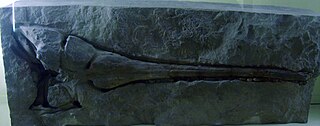
Pholidosaurus is an extinct genus of neosuchian crocodylomorph. It is the type genus of the family Pholidosauridae. Fossils have been found in northwestern Germany. The genus is known to have existed during the Berriasian-Albian stages of the Early Cretaceous. Fossil material found from the Annero and Jydegård Formations in Skåne, Sweden and on the island of Bornholm, Denmark, have been referred to as a mesoeucrocodylian, and possibly represent the genus Pholidosaurus.

Sebecus is an extinct genus of sebecid crocodylomorph from Eocene of South America. Fossils have been found in among others Patagonia. Like other sebecosuchians, it was entirely terrestrial and carnivorous. The genus is currently represented by a single species, the type S. icaeorhinus. Several other species have been referred to Sebecus, but were later reclassified as their own genera.
Phosphatosaurus is an extinct genus of dyrosaurid crocodylomorph. It existed during the early Eocene, with fossils having been found from North Africa in Tunisia and Mali. Named in 1955, Phosphatosaurus is a monotypic genus; the type species is P. gavialoides. A specimen has been discovered from Niger, but it cannot be classified at the species level.
Sunosuchus is an extinct genus of goniopholidid mesoeucrocodylian. Fossils are known from China, Kyrgyzstan, and Thailand and are Jurassic in age, although some may be Early Cretaceous. Four species are currently assigned to the genus: the type species S. miaoi and the species S. junggarensis, S. shartegensis, and S. shunanensis. All species are from China. Goniopholis phuwiangensis, also from Thailand, was reassigned to Sunosuchus by Andrade et al. (2011). The material from Kyrgyzstan has not been assigned to any species.

Ischyrochampsa is an extinct genus of Late Cretaceous mesoeucrocodylian belonging to the eusuchian clade Allodaposuchidae. Fossils of the type species I. meridionalis are late Campanian in age and were found in the commune of Saint-Estève-Janson in Bouches-du-Rhône, France. Material is also known from Spain. At an estimated length of over 4 metres (13 ft), Ischyrochampsa was a large mesoeucrocodylian. It was named and described in 1995.
Shantungosuchus is an extinct genus of Early Cretaceous crocodyliform found in China. It includes three species: Shantungosuchus chuhsienensis and S. brachycephalus, which were both described by Yang Zhongjian – usually referred to as "Young" – in 1961 and 1982, and S. hangjinensis, which was described by Xiao-Chun Wu et al in 1994. S. chuhsienensis is the type for this genus.

Coelognathosuchia is an extinct clade of neosuchian crocodyliforms that includes Goniopholididae and Pholidosauridae, two families of superficially crocodile-like aquatic crocodyliforms from the Mesozoic. Martin et al. (2014) named the clade after finding goniopholidids and pholidosaurids to group together in their phylogenetic analysis of crocodyliform evolutionary relationships. In their analysis, Pholidosauridae was monophyletic and Goniopholididae was paraphyletic, being an assemblage of successively more basal taxa within Coelognathosuchia. Coelognathosuchia itself was positioned near the base of the larger clade Neosuchia as the sister group to a clade containing the Early Cretaceous neosuchian Bernissartia and Eusuchia, the group that includes all modern crocodilians and their closest extinct relatives.

The El Molino Formation is a Maastrichtian geologic formation pertaining to the Puca Group of central Bolivia. The formation comprises fine-grained sandstones and sandy limestones with stromatolites deposited in a shallow marine to lacustrine environment. The formation has provided fossils of Dolichochampsa minima, and ichnofossils of Ankylosauria indet., Ornithopoda indet., Theropoda indet. and Titanosauridae indet. The tracksite of Cal Orcko is the best known example of the ichnofossil locations of the formation. The ichnofossil of Ligabueichnum bolivianum may be attributed to an ankylosaur. The fossil fish species Dasyatis molinoensis is named after the formation.














